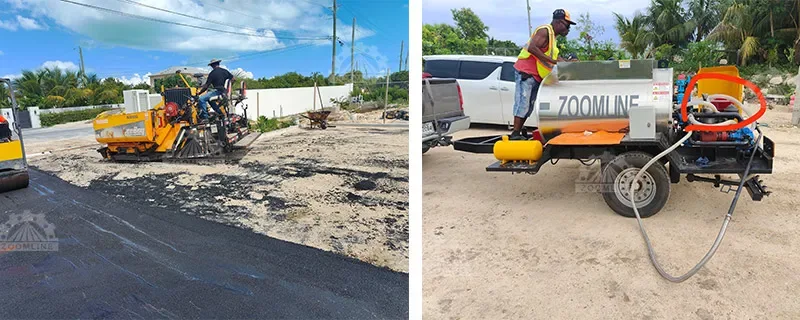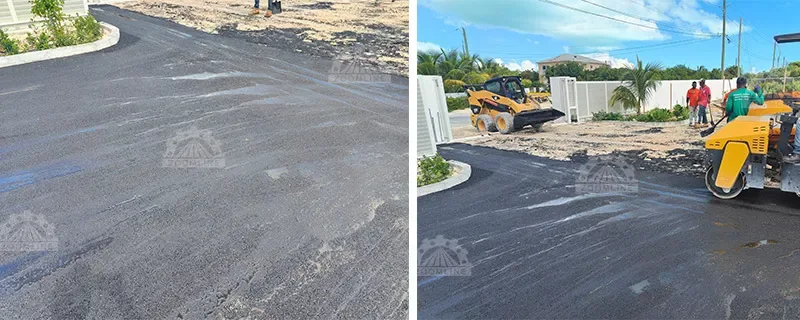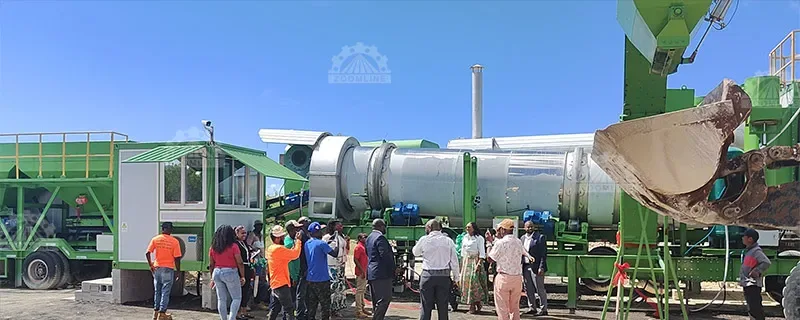Asphalt pavement, with its outstanding advantages such as high smoothness, strong wear resistance, short construction period, and good noise reduction, has become the mainstream choice for urban roads, highways, and industrial park roads. It not only improves driving comfort but also accommodates a certain degree of subgrade deformation, reducing later maintenance costs.
The service life and user experience of the pavement depend crucially on the standardization of the construction process—from initial preparation to post-construction maintenance, meticulous control of every detail directly affects the pavement’s strength, stability, and durability.
This article will comprehensively break down the entire asphalt pavement construction process, from pre-construction preparation and core construction steps to quality inspection and post-construction maintenance, providing a systematic and practical operational guide for practitioners, project managers, and related learners.
A site survey before construction is a prerequisite for ensuring project quality. A professional team needs to conduct a comprehensive investigation of the construction area, clarifying key information such as soil type, groundwater level, underground pipeline distribution, and surrounding building conditions to avoid problems such as pipeline damage and roadbed settlement during construction.
Based on the survey results, a detailed construction plan should be developed: The thickness of the pavement structure layer should be determined according to the road’s usage requirements (e.g., urban arterial roads, community secondary roads), the road slope should be planned to ensure smooth drainage, and drainage systems such as storm drains and drainage ditches should be designed to prevent long-term water accumulation and subsequent road surface damage.
Simultaneously, fencing and warning signs should be set up in the construction area, construction access roads and pedestrian access roads should be separated, and safety protection measures should be implemented to prevent accidents during construction.
The core materials of asphalt pavement include asphalt mixture, aggregates, and fillers, and their quality directly determines the pavement performance. Asphalt mixtures must be selected according to the road grade, requiring good high-temperature stability, low-temperature crack resistance, and water stability. Aggregates should be hard, well-graded crushed stone or gravel to ensure compressive strength and abrasion resistance. Fillers are typically limestone powder, and their fineness and purity must meet standards.
Upon arrival, materials must undergo rigorous inspection: testing the asphalt’s penetration, ductility, and softening point; verifying the aggregate gradation, crushing value, and abrasion rate; and confirming the filler’s particle size distribution and moisture content. Unqualified materials are strictly prohibited from entering the site.
Material storage must adhere to regulations: Asphalt should be stored in sealed, dedicated storage tanks with proper insulation; aggregates should be stacked separately, protected from rain and moisture, and mixed with different aggregate sizes to prevent gradation imbalance; fillers must be stored in a moisture-proof environment to prevent clumping and ensure optimal performance.
The performance of core construction equipment directly affects construction efficiency and quality; therefore, all equipment must be prepared and commissioned in advance. Essential equipment includes asphalt mixing plants, pavers, double-drum rollers, rubber-tired rollers, loaders, transport vehicles, and core sampling machines.
Before equipment arrives on site, technicians must conduct a comprehensive inspection of each piece of equipment: checking the mixing blades and temperature control system of the mixing plant to ensure uniform mixing and temperature compliance; adjusting the paving thickness adjustment device and travel system of the paver to ensure paving smoothness; and testing the compaction strength and travel stability of the roller to avoid poor compaction results.
The construction team must have a clear division of labor: technicians are responsible for implementing the construction plan, adjusting parameters, and providing technical guidance; operators must undergo professional training and be proficient in equipment operation procedures; quality supervisors will monitor the entire construction process, promptly identifying and resolving quality issues; and safety managers are responsible for on-site safety management to ensure standardized and orderly construction.

The base layer is the “foundation” of the asphalt pavement and must possess sufficient strength and stability; otherwise, pavement settlement and cracking will occur. The first step in base treatment is cleaning, thoroughly removing surface debris, loose soil, weeds, and draining accumulated water to ensure the base surface is clean and dry.
Subsequently, base leveling and compaction are carried out: a grader is used to spread the base material evenly, adjusting the flatness according to the design slope, and then a roller is used to compact it in layers, achieving the design standard (usually not less than 95%). Real-time monitoring is required during compaction; if local settlement or bulging occurs, leveling should be carried out promptly.
For defects such as cracks and potholes in the base layer, repairs must be made in advance: for small cracks, sealant is injected for filling; for larger cracks or potholes, the damaged areas must be cut and cleaned, filled with the same grade of base material, and compacted to ensure the overall base layer is flat and dense.
The quality of asphalt mixture mixing is crucial for pavement construction, with mix design and temperature control being paramount. Based on the road’s intended use and load requirements, the optimal mix proportions of asphalt, aggregates, and fillers are determined through testing to ensure the mixture possesses good workability, strength, and durability.
During mixing, the mixing plant must strictly adhere to the mix proportions, controlling the mixing time (typically 30-60 seconds) to ensure a uniform mixture free from white spots and clumping. Temperature control is particularly important: the asphalt heating temperature must be maintained at 150-170℃, the aggregate heating temperature at 160-180℃, and the mixture’s outlet temperature controlled at 140-165℃. Excessive temperature can lead to asphalt aging, while insufficient temperature can negatively impact paving and compaction.
After mixing, the mixture undergoes quality inspection: observing for uniformity and testing indicators such as Marshall stability and flow value. Only mixtures meeting design requirements are allowed for shipment.
Asphalt mixture transportation requires specialized vehicles with insulated cargo compartments. The inner walls of the compartments must be coated with a release agent to prevent the mixture from sticking together. Before transportation, check the cargo compartment’s sealing and cover it with a rainproof tarpaulin to prevent rainwater ingress and reduce temperature loss.
Transport routes should be planned in advance to minimize transportation time, typically not exceeding 30 minutes, to avoid excessive cooling or segregation of the mixture during transport. Upon arrival at the construction site, vehicles must queue in an orderly manner and unload slowly and evenly. During unloading, vehicles should move back and forth to reduce segregation caused by mixture accumulation.
Unloading must be directed by a designated person to ensure accurate unloading into the paver hopper, preventing spillage on the base surface that could lead to waste or affect construction. If the mixture’s factory temperature is too high, it has become damp during transportation, or severe segregation has occurred, it should be discarded and not used for paving.
Before paving, the base surface must be inspected again to ensure it is clean, dry, and smooth. Any debris or standing water must be removed promptly. The paver parameters need to be adjusted in advance: adjust the screed height according to the design thickness, set the travel speed (usually 2-6 m/min), and maintain a constant speed to avoid interruptions that could lead to joints or poor smoothness.
A continuous paving method should be used, ensuring sufficient mix remains in the paver hopper at all times to prevent uneven paving thickness due to insufficient mix. The screed must be preheated to above 100℃ to ensure rapid setting of the mix after paving and reduce adhesion.
For road edges and junctions with existing road surfaces or structures, manual paving assistance is required to ensure straight edges and tight connections. During paving, technicians should monitor the paving thickness and smoothness in real time. If deviations occur, paver parameters should be adjusted promptly or manual leveling should be performed.
Compaction operations consist of three stages: initial compaction, intermediate compaction, and final compaction. Different compaction machinery is selected for each stage, following the principle of “lighter compaction first, heavier compaction later; slower compaction first, faster compaction later; edges first, then the center.”
The primary purpose of initial compaction is to stabilize the mixture. A double-drum roller is used, with a travel speed controlled at 2-3 km/h, and 1-2 passes are performed. The compaction temperature is maintained at 120-140℃. During initial compaction, sudden braking and sharp turns of the roller should be avoided to prevent the mixture from shifting.
Intermediate compaction is the crucial stage for improving road surface density. A rubber-tired roller or a heavy-duty double-drum roller is used, with a travel speed of 3-5 km/h, and 4-6 passes are performed to ensure that the compaction degree meets the design standard (usually not less than 96%). During intermediate compaction, the compaction direction should be alternately changed to avoid compaction marks.
Final compaction aims to eliminate road surface compaction marks and improve smoothness. A light-duty double-drum roller is used, with a travel speed of 4-6 km/h, and 1-2 passes are performed. The compaction temperature should not be lower than 70℃. After final compaction, the road surface should be smooth, dense, and free of obvious wheel tracks, cracks, or looseness.

Appearance quality is a direct reflection of pavement construction quality. A 3-meter straightedge is used to check pavement flatness; the gap between the straightedge and the pavement should not exceed 3mm. A comprehensive inspection of the pavement surface is conducted, ensuring no defects such as cracks, looseness, displacement, or bleeding are present. The straightness of the road edges is checked, with a deviation not exceeding 5cm. Simultaneously, the pavement elevation is checked to ensure it meets design requirements.
If local flatness is found to be substandard, manual grinding or patching is required. Minor cracks can be promptly sealed with sealant; severe defects require cutting, cleaning, and re-laying and compaction.
Core performance testing is a crucial step in verifying pavement quality. Compaction degree testing can be performed using core drilling or nuclear density metering: Core drilling involves drilling a core sample from the pavement and measuring its density ratio to the design density to ensure compliance with compaction standards; nuclear density metering allows for rapid detection of pavement density and is suitable for real-time on-site monitoring.
Thickness testing employs core drilling sampling, with the pavement thickness deviation at each testing point not exceeding ±5% of the design thickness. Permeability coefficient testing utilizes a permeability meter to ensure good drainage performance and prevent rainwater infiltration into the base layer. Skid resistance testing employs a pendulum meter or sand-laying method to guarantee the pavement’s skid resistance and improve traffic safety.
All test items must be judged against industry standards and design requirements, and test data must be recorded and archived in detail. If all test results are qualified (qualified/compliant), the pavement can proceed to the later maintenance stage. If any non-compliant areas exist, the causes must be analyzed, and targeted corrective measures must be developed: insufficient compaction requires additional compaction, insufficient thickness requires re-laying, and substandard performance requires partial rework. After rectification, retesting is conducted until the standards are met.
After asphalt pavement construction, initial maintenance is required, typically lasting 7-14 days, adjusted according to temperature and asphalt mixture type. During the maintenance period, all vehicles, especially heavy vehicles, are prohibited from passing through to prevent pavement deformation or damage.
If high temperatures occur during the maintenance period, appropriate watering is necessary to maintain moisture and prevent pavement cracking. If rainfall occurs, accumulated water must be promptly drained to prevent rainwater from seeping into the base layer and affecting stability. Traffic can only be opened after initial maintenance and confirmation of pavement stability.
Daily maintenance focuses on keeping the pavement clean, regularly sweeping away debris and dust to prevent sharp objects from scratching the pavement or debris from clogging the drainage system. A regular inspection system should be established, with at least one inspection per week to promptly detect early cracks, potholes, loosening, and other problems, ensuring early detection and treatment.
Preventative maintenance is key to extending pavement life. Depending on pavement usage, regular sealing or overlay applications are necessary: sealing enhances waterproofing and prevents rainwater infiltration; overlays repair minor pavement defects, improve smoothness and skid resistance, and are typically performed every 3-5 years.
Common asphalt pavement defects include cracks, potholes, ruts, and subsidence, requiring targeted treatment. Crack Treatment: For minor cracks less than 5mm wide, inject asphalt sealant to fill; for cracks wider than 5mm, cut into V-grooves, clean, fill with sealant, and compact; large cracks can be reinforced with joint tape.
Pothole Repair: First, cut and demarcate the damaged area to the stable base layer. Thoroughly clean the damaged area of debris and dust, spray with tack coat, fill with asphalt mixture, and compact, ensuring a smooth transition between the repaired area and the original pavement.
Rutting and subsidence treatment: Minor rutting can be repaired by milling the surface and then repaving; severe rutting or subsidence requires checking the stability of the base layer. If the base layer is damaged, it must be repaired first before the surface layer is laid.

Asphalt pavement construction is a systematic project, with its core being “full-process quality control”—four interconnected and indispensable stages: thorough preparation before construction, precise operation during construction, rigorous testing after construction, and scientific maintenance.
A standardized construction process not only ensures the strength, smoothness, and stability of the pavement but also significantly extends its service life and reduces total life-cycle maintenance costs. With the development of road construction technology, environmentally friendly asphalt mixtures and intelligent construction equipment will be gradually promoted and applied, bringing more efficient, environmentally friendly, and high-quality solutions for asphalt pavement construction.
Whether you are an engineering professional or a student, mastering the key points of the entire asphalt pavement construction process and strictly adhering to industry norms and technical standards are essential to creating safe, durable, and comfortable road projects.